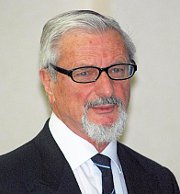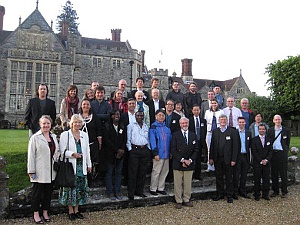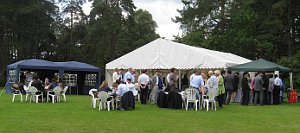Environmental Impact 2012
1st International Conference on Environmental and Economic Impact on Sustainable Development
3 - 5 July 2012
New Forest, UK
Overview

The 1st International Conference on Environmental and Economic Impact on Sustainable Development, incorporating Environmental Economics, Toxicology and Brownfields, has recently taken place in the New Forest, UK, the location of the Wessex Institute of Technology. The meeting was organised by the Institute, represented by Prof Carlos A Brebbia and Punan National University, South Korea, represented by Prof T-S Chon.
The meeting originated from the need to provide an interdisciplinary forum where the most serious problems affecting sustainable development could be discussed. The basic premise is that development projects need to consider the most important issues related to environmental impacts in order to provide complete solutions.
The conference discussed how to assess the impact of economic constraints on the environment considering the social aspects as well as any resulting environmental damage. The overuse of natural resources and the resulting pollution of the environment need to be understood in financial terms.
Uncontrolled development can result in damage to the environment in terms of the release of toxic substances and hazardous waste. The increasing number of new chemical components poses major challenges to the environment as it is difficult in many cases to predict their effects and take appropriate decisions. Their economic impact can be particularly challenging.

The demand for developed land has led to the reuse of properties that have been abandoned for a variety of reasons. Many of them are brownfields, sites which have deteriorated in different ways, including by contamination. These sites are usually a burden in terms of economic losses and contribute to the deterioration of the quality of life in entire neighbourhoods. Rehabilitation of local fields, particularly those that are contaminated can be an expensive undertaking and require not only technical solutions but also the involvement of financial, regulatory and community stakeholders. Fundamental to this process is the analysis of the risks involved in the development of appropriate strategies.
The conference addressed problems of great importance discussing more constructive and progressive approaches to learn from past failures, to avoid repeating similar mistakes, while attempting to prevent emerging threats to the environment and ecological systems.
Opening Address

WIT skills lay in the development of advance techniques for the computer solution of engineering and scientific problems, within a wide range of applications which allows the Institute to participate in many international initiatives, including EU projects. WIT is aware – Carlos stated – of the need to find solutions that comprise the social and economic aspects as well as technical matters. Only by advancing collaboration amongst different disciplines can the serious problems affecting society be solved.
Carlos then described a number of the projects recently undertaken at the Wessex Institute, including some which are carried out for the engineering and aerospace industries.
WIT Press, the academic publishers for the Wessex Institute, produces not only conference books, but also a wide range of monographs and edited books. It has also launched a series of interdisciplinary academic journals to cover publications that are not currently considered by the major commercial publishers. These activities – Carlos said – are an essential part of WIT’s objectives as they help to disseminate the work of all those associated with WIT. This conference material for instance is now distributed in digital as well as paper format with all papers archived in http://library.witpress.com/.
Carlos ended by thanking the participants for having come to the conference and wishing them a successful meeting. He also expressed his gratitude to the members of the International Scientific Advisory Committee for their help in reviewing the papers and promoting the conference.
Conference Topics
The meeting considered a series of important topics, grouped as follows:
- Environmental policies and planning
- Environmental assessments
- Development issues
- Sustainable city
- Economic analysis
- Nature resources management
- Energy and the environment
- Food and the environment
- Ecosystems health
- Brownfields rehabilitation
- Waster resources management
- Soil contamination
- Air and water pollution
- Toxicity studies
- Environmental health risk
- Risk analysis
Invited Presentations

‘Improving environmental assessment of nature: Methodological considerations and practical solutions’
by J M Vleugel, Delft University of Technology, The Netherlands
‘Evaluation of rehabilitation alternatives at the abandoned Avoca Mining Site in Ireland’
by R L Olsen, CDM, USA
‘Engineering environmental site investigations in the oil-fields of Western Urals: peculiarities and problems’
by V I Sturman, Udmurt State University, Russia
‘Financial planning for the decommissioning of a nuclear power plant’
by R Sjöblom, Tekedo AB, Sweden
‘Development of renewable energy strategies for small urban area’
by C Brandoni, Università Telematica e-CAMPUS, Italy
‘Vulnerability of water source selected for emergency water supply in the Czech Republic’
by E Bakos, University of Defense, Czech Republic
ISAC Dinner
The International Scientific Advisory Committee of the conference met over dinner to discuss how to improve the meeting when it is reconvened in 2014. Several new topics were proposed with the emphasis on making the meeting more transdisciplinary as it was felt this was the strength of the conference, ie able to bring together participants from different backgrounds. A number of colleagues were proposed to join the Committee and several locations for the next meeting were put forward. Carlos will see that the Conference Division investigates possible venues to find the best suited for Environmental Impact 2014.
Social Occasions
The delegates have numerous occasions for informal discussions during the social functions that took place during the conference as well as in the refreshment breaks, which included complimentary lunches, as well as coffee.

In addition they were invited to participate in a lunchtime excursion to one of the most beautiful sites in the New Forest, ie Bucklers Hard, to which they were taken by bus and offered a packed lunch.
Bucklers Hard is a very picturesque village of great historical interest lying on the Beaulieu River. It was a shipbuilding centre, which at its height had five slipways and around 20 cottages for the workers. Only two rows of cottages now remain with a broad village street separating them and sloping towards the river. At the end of one row stands a hotel, which was the Master Builder’s house. An excellent display at the entrance of the village describes the activities that took place there.
Many fine wooden ships were built there including the famous Agamemnon, commanded by Nelson during the siege of Calvi, in which he lost the vision of his right eye. This ship, together with Swiftsure and Euryalus, all built at Bucklers Hard, took part in the Battle of Trafalgar.
The delegates were able to walk around the village and visit the pub as well as a tiny chapel located in one of the builders’ cottages.
The conference dinner took place in Rhinefield House, one of the most impressive houses in the New Forest. Now a luxury hotel, it was originally a private resident of the Walker-Munro family, and built with the dowry of the bride at the end of the XIXth century.
The house has been built in a style loosely resembling a Scottish castle with a series of rooms decorated differently. The dinner took place in the most magnificent of them all, the Great Hall, a hammer-beam style roof, following that of the Old Westminster Hall in the Houses of Parliament.
Before dinner the delegates were guided around the garden by Carlos Brebbia, who showed them the amphitheatre and maze, as well as the water fountain features of the gardens.
Rhinefield House has other attractions, such as its Italianate and French style dining rooms, a beautiful wood panelled restaurant dominated by a carving depicting the defeat of the Spanish Armada and a small room in the style of the Alhambra of Granada.

The meal was of excellent standard and the dishes accompanied by good red and white wines. At the end of the meal Carlos offered each participant a hand made bowl, the work of a local potter. Each bowl was individually decorated. Carlos hoped that the souvenir will remind them of the conference and of the New Forest.
Carlos closed the meeting by thanking all the delegates for coming and reminding them of the possibility of collaborating with WIT in the future. He also hoped that many of the presenters will consider extending their paper for publication in one of the Journals. He also hoped that they will consider attending another of the WIT meetings in the future.
Following these remarks he invited all to participate in a lamb BBQ in the Campus of the Wessex Institute where they were shown some of the buildings, including the recent swimming pool and gym. The occasion was friendly and relaxed, which helped to strengthen the links between the delegates
Conference Proceedings
The proceedings of Environmental Impact, 300pp (Print ISBN:978-1-84564-604-2; eISBN: 978-1-84564-605-9) are available from WIT Press. Orders can be placed on the WIT Press web site at www.witpress.com or by email:Papers from the conference will also be hosted online at the WIT eLibrary as Volume 162 of WIT Transactions on Ecology and the Environment ISSN: 1746-448X, Digital ISSN 1743-3541). For more details visit the WIT eLibrary at http://library.witpress.com

 Wessex Institute
Wessex Institute